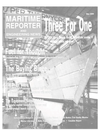
Page 45: of Maritime Reporter Magazine (May 2000)
Read this page in Pdf, Flash or Html5 edition of May 2000 Maritime Reporter Magazine
Lubricant Technology Proven Tough Under Fir<
When Texaco, now represented in the marine lubri- cants market by FAMM (Fuel and Marine Marketing), launched Taro 40 XL 40, the lubricant was designed to address pressing field problems in medium speed engines. Three years later FAMM is in a position to evaluate the performance in a large number of engines and to compare the field results with competitive lubri- cants. The pressing problems arose from a series of engine design and fuel processing changes. Although aimed at improving engine efficiency and making sav- ings, the changes resulted in a series of difficulties.
The best known are engine blackening, undercrown deposits, piston head corrosion, fouling of purifier heaters, increased oil consumption, base number depletion, oil scraper ring clogging and increased pis- ton deposits. To operate the new medium speed engines satisfactorily, a new generation of lubricants was need- ed. The new oils had to be able to disperse high con- centrations of cracked asphaltenes in the lubricant and have enhanced thermal stability to resist extreme tem- perature conditions.
To understand the impact of the new lubricant gener- ation on the field performance, it is necessary to look into the causes of the field problems and the working mechanisms of the new lubricants.
Fig 1: Typical blackening of a cambox due to 4 percent HFO contamination of the lubricant
Fig 2: A cambox lubricated with Taro 40 XL 40, despite a high
HFO contamination level of 4 percent, the blackening is fully eliminated.
Engine blackening through fuel contamination
In modern medium speed diesel engines the fuel pump pressure has been increased, sometimes up to 1600 bar. This contributed to high fuel pump leakage and increased fuel contamination of the lubricant.
Analyses of used oils from medium speed engines run- ning on heavy fuel (HFO) indicated an average HFO contamination of two percent. In some cases levels up to 15 percent were detected.
Most of the HFOs in use today come from cracking installations. The cracked asphaltenes, an inherent part of modern HFOs, don't dissolve in lubricants but instead coagulate and form floating asphalt particles of two to five microns. These particles are very sticky and form black deposits on all metal surfaces of the engine.
These result in black deposits in the cambox and in the crankcase. The deposits also cause oil scraper ring clogging. This can lead to high oil consumption.
Deposits are also formed in the hot areas of the engine such as the piston grooves, the piston lands and in the cooling spaces of the piston. If an oil barrier is used to seal the fuel pump, asphaltene coagulation can occur on the surface of the fuel pump plunger, some- times leading to fuel pump blockages. These deposits
Fig 3: Crankcase blackening due to heavy fuel contamination can obstruct the fuel pump drain. This results in exces- sive fuel ingress into the lube oil, aggravating the deposit problems and causing serious viscosity increases due to fuel admixture.
Significant differences in the degree of blackening can be observed in the field. The differences are large- ly due to purification conditions and fuel pump type.
The problems can be minimised by effective purifica- tion, which removes the asphalt particles from the lubricant. Extreme engine blackening is experienced in case of poor purification in combination with high
HFO pump leakage.
Solutions
It was to resolve these problems that the new lubri- cant technology was developed. In the latest generation of lubricants, asphaltenes are dispersed in the lubricant.
Inspection of a high number of engines of different makes, which have accumulated up to 20,000 hours with Taro 40 XL 40, show excellent general cleanliness and considerably improved piston cleanliness. Excel- lent results are obtained even with high HFO contami- nation levels up to 8 percent. Product testing in the lab- oratory and engine inspections in the field indicate that there is a substantial difference between the perfor- mance of the different commercial oils on the market.
In particular, the amount of asphaltenes that can be dis- persed is significantly different. This is reflected in the high number of dirty engines still found in the field.
Engines with a relatively high level of HFO contami- nation and a moderate oil quality still suffer asphaltene deposits, heavy deposit formation in purifiers, in puri- fier heaters, high filter consumption etc.
FAMM found that of all the tested commercial lubri- cants, Taro 40 XL 40 was able to disperse the highest level of cracked asphaltenes. Nearly all engines lubri- cated with Taro 40 XL 40 were fully clean. Excellent piston cleanliness was obtained. The cleaning intervals of the purifiers were reduced as was, in many cases, fil- ter consumption. Deposit formation in purifier heaters was almost eliminated.
The field results obtained with Taro 40 XL 40 are illustrated in Figures 1 to 4.
They show the cleanliness obtained with the new lubricant as compared with the previous generation of oil. Figure 1 shows typical blackening of a cambox due to 4percent HFO contamination of the lubricant.
Figure 2 shows a cambox lubricated with Taro 40 XL 40, despite a high HFO contamination level of 4 per- cent, the blackening is fully eliminated.
Figures 3 and 4 compare crankcase cleanliness in an (Continued on page 63)
Fig 4: A clean crankcase operating with Taro 40 XL 40 Fig 5: Carbon layer build up in cooling chamber Fig 6: A similar cooling chamber in an engine lubricated with
Taro 40 XL 40

 44
44

 46
46
